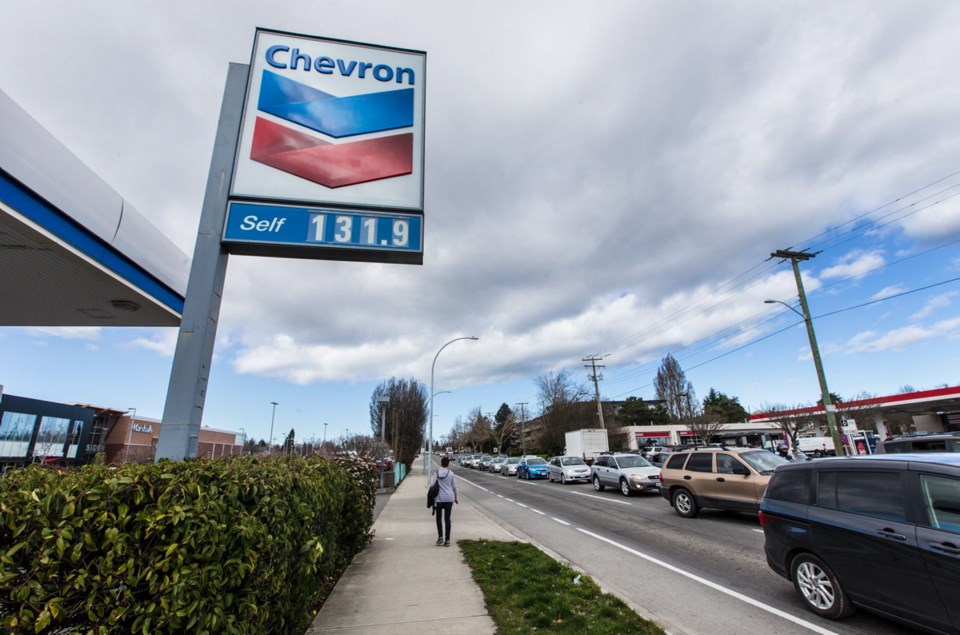Victoria makes a lot of Top 10 lists: Most livable, most romantic, best to visit. …
As of Thursday, we made another: Third most expensive gasoline in North America, just after Vancouver and St. John’s, N.L., according to Gasbuddy.com.
Yeah baby, No. 3. The price jumped seven cents a litre in a single day, to $1.319 from $1.249. If we try harder, maybe we can hit No. 2 next week.
The reason for the spike is pretty straightforward, says Dan McTeague, senior petroleum analyst with Gasbuddy.com, the price-tracking website. But, he says, it’s also an example of what happens when we allow ourselves to become overly reliant on our neighbours in the U.S.
This week’s bump at the pump reflects what’s going on in Washington state, where the wholesale price of gas has risen eight cents a litre thanks to a supply squeeze. The Phillips 66 refinery in Ferndale, just outside Bellingham, has had problems that have prevented it from coming out of a maintenance shutdown. Compounding that problem is a planned shutdown at BP’s nearby Cherry Point refinery, which will close for maintenance on Monday. The combination is expected to keep prices high for a couple of weeks.
Then we’ll hit April 15, when the refineries switch to summer blends, which will push the price up by maybe three cents a litre. In winter the gas in your tank includes cheaper components, such as butane, that can’t be used in the summer because they evaporate when the temperature rises. More expensive ingredients are added from mid-April through mid-September.
OK, that explains the short-term spike.
It doesn’t, however, explain how we allowed ourselves to come to a place where we are at the mercy of American refineries that are free to charge us whatever they want -- and do.
The wholesale price paid by Canadians is usually 11 cents a litre higher than that charged Americans for the same gas coming out of the same refineries, McTeague says.
It that sounds like a lot, well, tough. There’s not much we can do about it, as we no longer have alternative sources of supply. B.C. used to have seven refineries but now has just two, the Chevron facility in Burnaby and a smaller one operated by Husky in Prince George. Having allowed most of our refineries to disappear, we rely on four big ones in Washington.
“They’re willing to produce gas for us, but at a price,” McTeague says. “We pay a pretty steep premium because of our inability to produce enough in our own backyard.”
“As buyers, we’re in a weak position,” McTeague says. If we balk, the refiners will simply sell the same gas to customers in San Francisco and Los Angeles.
Not that we ever really balk. For all our moaning about gas prices, Canadians are a compliant lot. We don’t engage in the same degree of consumer activism as is seen in the U.S. or Britain, McTeague says. Having surrendered control, Canadians are accepting of the consequences.
How did we get here? Canada had 40 refineries before the oil price shocks of the 1970s prompted a switch to other sources of energy -- electricity, natural gas -- and forced automakers to produce cars with better fuel economy.
As a result, demand fell and smaller refineries closed, says Natural Resources Canada. McTeague thinks NRC is leaving out oil industry monopolies, acquisitions and mergers as factors in “a dangerous amount of closures in this country.”
Today, Canada has just 14 refineries producing gasoline, and even then pretty much every other region of the country is in a better position than the West Coast, he says. Refineries in Ontario and Quebec make that area self-sufficient, while those in the Maritimes actually have enough capacity to export to the States. Alberta and Saskatchewan increased capacity to meet demand.
B.C., on the other hand, depends on the Americans being willing to keep the taps open.
“You are vulnerable,” McTeague said from Oakville, Ont. “When the Americans have a problem, you have an even greater problem.”
The third most-expensive gas in North America? Imagine no gas at all.



